Stan Ockers
 Thu, March 15, 2012
Thu, March 15, 2012 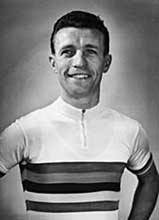 Belgian cyclist Constantin “Stan” Ockers (Right.) was another hero of my youth.
Belgian cyclist Constantin “Stan” Ockers (Right.) was another hero of my youth.
He was around in the era of riders like Fausto Coppi, Gino Bartelli, Louison Bobet, and other great riders of the 1950s.
Born in 1920, Stan Ockers began his professional career in 1941 in occupied Europe at the height of WWII.
He was a sprinter and won many of his races that way; He won the Green Points Jersey in the Tour de France in 1955, and 1956.
However, he was a good climber too, which was unusual then and would be even more unusual today when the sprinters are usually the first ones dropped when the TDF reaches the mountain stages.
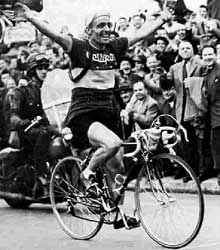 Ockers was 2nd in the 1950 tour de France behind Swiss rider Ferdi Kubler; and proof of his climbing ability he was also 2nd in the King of the Mountains category.
Ockers was 2nd in the 1950 tour de France behind Swiss rider Ferdi Kubler; and proof of his climbing ability he was also 2nd in the King of the Mountains category.
A young French cyclist Louison Bobet won the King of the Mountains Jersey that year, and was overall 3rdin the General Classification behind Ockers.
Bobet would go on to become the first rider to win three consecutive Tour de France titles in 1953, 1954 and 1955.
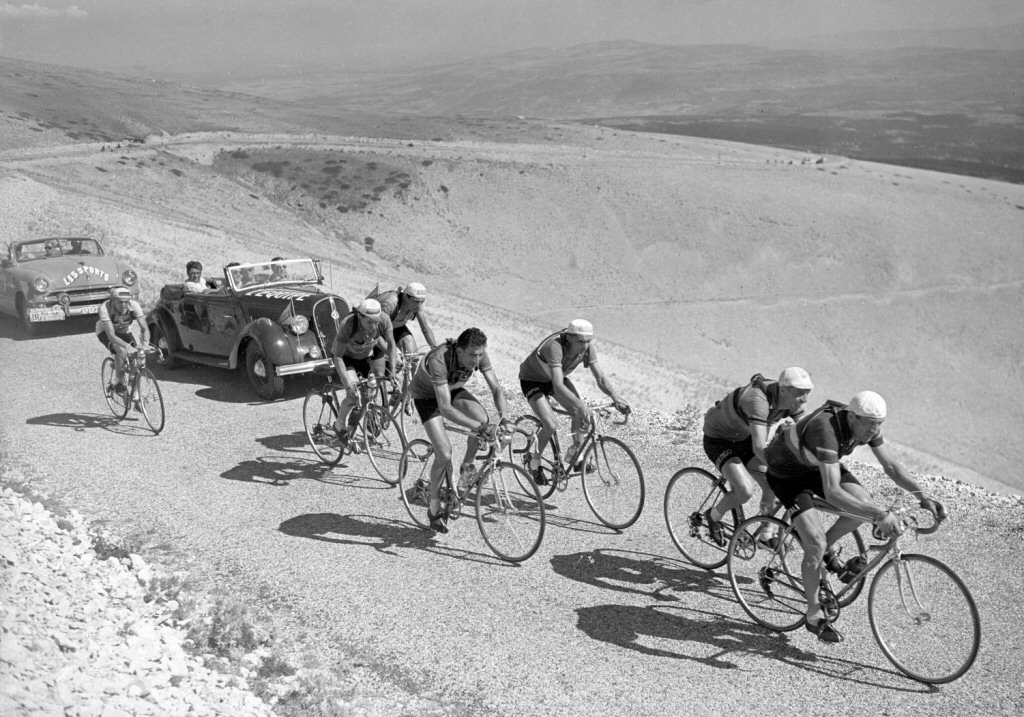 The picture above is from the 1952 Tour de France, the riders are seen climbing Mont Ventoux; one of the toughest climbs of the Tour. Gino Bartali leads Stan Ockers, followed by Jean Dotto, Raphaël Géminiani, Fausto Coppi, Antonio Gelabert and Wout Wagtmans.
The picture above is from the 1952 Tour de France, the riders are seen climbing Mont Ventoux; one of the toughest climbs of the Tour. Gino Bartali leads Stan Ockers, followed by Jean Dotto, Raphaël Géminiani, Fausto Coppi, Antonio Gelabert and Wout Wagtmans.
To hold one’s own in the company of some of the world’s best climbers of that era, is the mark of a great all-round athlete. Stan Ockers was once again 2nd in the 1952 TDF behind one of the all time greats, Fausto Coppi.

(Above left to right.) Bernardo Ruiz, Gino Bartali, Stan Ockers and Fausto Coppi
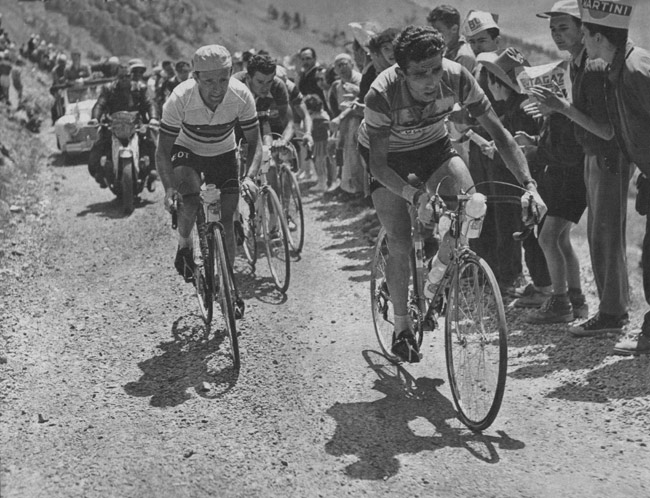 (Above.) Federico Bahamontes leads Stan Ockers (In his World Champions Jersey.) and Roger Walkowiak in the 1956 TDF. Notice the condition of the roads on these mountain climbs during that era.
(Above.) Federico Bahamontes leads Stan Ockers (In his World Champions Jersey.) and Roger Walkowiak in the 1956 TDF. Notice the condition of the roads on these mountain climbs during that era.
Stan Ockers actually improved as he aged; 1955 and 1956 when Stan was 35 and 36 years old, were in terms of wins, his best seasons. He won the World Road Championship in 1955 and was 4th the following year.
In 1955 his wins in the Classics included, Liège-Bastogne-Liège, La Flèche Wallonne, Liège, Weekend Ardennais. The following year 1956, Ockers was 1st overall Roma-Napoli-Roma, won the 19th stage tour de France, Saint-Etienne, and was again Points Winner in the TDF.
 Like many great road sprinters, Stan Ockers rode the track during the winter season.
Like many great road sprinters, Stan Ockers rode the track during the winter season.
He often partnered the other great Belgian road sprinter Rik Van Steenbergen in Six Day events.
He won the Antwerp Six Day in 1956, and that same year set a new Derny Paced Hour Record. (Derny Paced pictured above right.)
Sadly 1956 was Stan Ockers last season. On September 29th 1956 he crashed during a race on the Antwerp track. He died from head injuries two days later.
Other riders, Nest Sterckx, Rik Van Looy and Gerrit Voorting, who along with Stan were involved in the seemingly ordinary fall, remained unhurt; a tragic end nobody had expected.
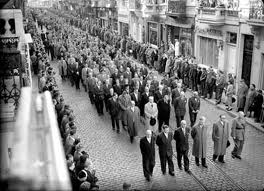
Crowds of people numbering in the tens of thousands paid their last respects as the funeral procession passed.(Picture left.)
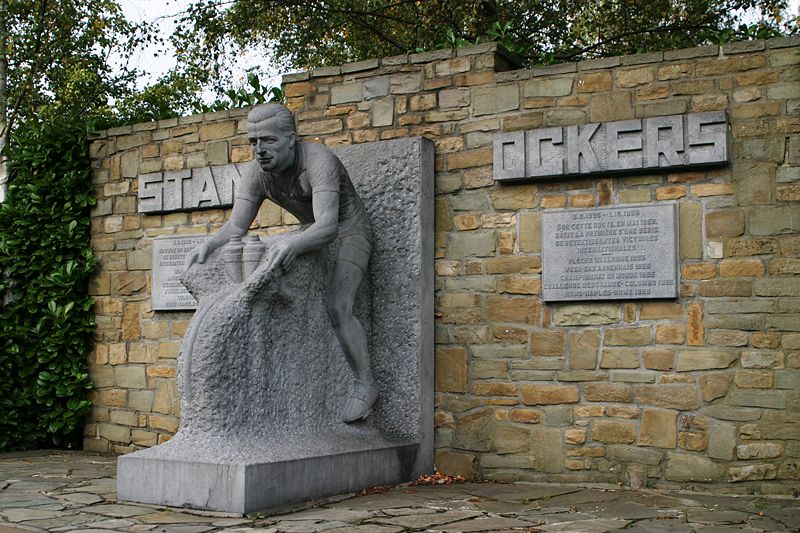
There is a permanent monument built to honor Stan Ockers on the slope of Les Forges in the Belgian Ardennes. (Picture above.) He is placed number 58 in the Cycling Hall of Fame Top 100
Addendum 2/18/16
(Above picture.) Stan Ockers bike a Girardengo, hangs in a pub in his home town of Borgerhout, Antwerp.
 Dave Moulton | Comments Off |
Dave Moulton | Comments Off | 






















Reader Comments (6)
Thanks for the story -- it's nice to be informed of other important cyclists. In the Hall of Fame 100 there are only two USA cyclists but both are in the Top 10. Surprised though that Cavendish remains off the list. Back to '09 weight but no repeat of '09 results in Milan-SanRemo.
Jack,
The top 100 is based on points scored; not number of wins. Here is the chart for current top 25 riders. Cavendish is is tied for 25th, one place behind Leipheimer.
Points are awarded for wins and placings in the Grand Tours, and for the Points and Mountains Jerseys; there are no points for individual stage wins. Then there are points for wins in the Classics. Here is how the points system is set up.
No system is perfect, but it does give a comparison with today's riders and those back 50, 60 or more years back.
It is an interesting chart, On the current rider's chart, Menchov and Basso are 5 and 6 based on their perfomance in Grand Tours, Gilbert and Cancellara are 13 and 14 based on their wins in one day classics.
Andy Schleck is 8th on the current chart, Di Luca is 9th, Cavendish 25th. Schleck and Di luca are currently 89th and 99th in the all time top 100. It appears Cavendish has a way to go, and needs to keep winning Classics and WC to move up.
Dave
Thanks for the additional info. The point system used by CHF is what concerns me or should it be how the major tours determine winners of points jerseys?
Points awarded TdF first place is 1800 vs. 810 for Giro and only 270 for the winner of the green in the TdF. That is a large spread in points awarded (rankings) between yellow and green. There is also a large spread, 1200 points, from first place to second place in the TdF.
I also believe that anyone who finishes a Grand Tour deserve points but I also realize how difficult it is to establish indices.
Great website, fun stuff. More rankings by Eric Bowen:
http://www.thevirtualmusette.com/posts/2010/10/27/top-100-cyclists-of-the-modern-era-end-of-year-update-2010.html
Thanks Dave for the solid overview and great pictures.
Eddy Merckx told me that his favorite rider and childhood hero was Stan Ockers and that he was deeply affected by his death when Merkcx was eleven or twelve years old.
Rene, do you happen to be a relative of Stan's?!